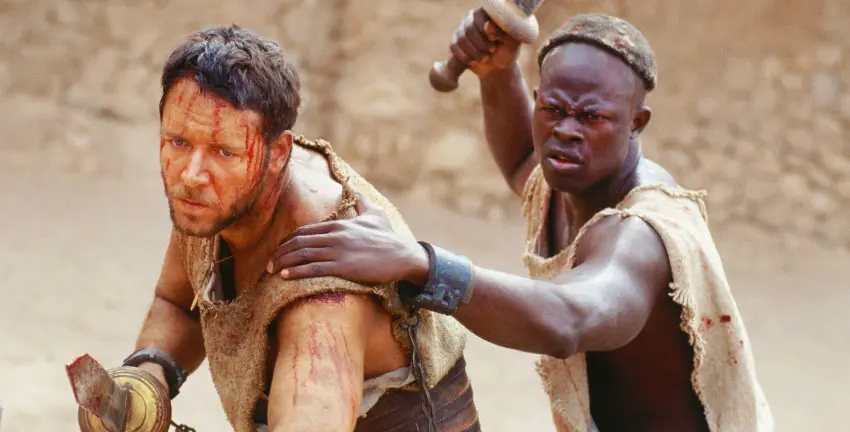
When Ridley Scott’s Gladiator hit the big screen in 2000, it captivated audiences worldwide with its thrilling tale of honor, vengeance, and redemption set in ancient Rome. The film’s grandeur, stunning visuals, and gripping performances made it an instant classic, so much so that nearly a quarter of a century later a sequel is finally on the way. However, what many might not know is that Gladiator drew inspiration from a real-life story, one that is equally as captivating, though with its own unique twists and turns. Sometimes reality is much stranger than fiction, so let’s find out What Really Happened To Gladiator?
Gladiator: Fact Vs Fiction
In the film, Maximus (played by Russell Crowe) is a legendary general in the army of the Roman Empire. The aged Emperor Marcus Aurelius decides to appoint Maximus as his successor over his own son Commodus (Joaquin Phoenix). This angers Commodus, who orders Maximus to be put to death, but the Roman general is able to escape before the sentence can be carried out. He hurries home to his wife and child only to find they have been killed.
While wallowing in his grief, Maximus is captured and put into slavery. It is here that he is put into gladiator combat by Proximo. At first, he refuses to fight, but soon his fighting skills kick in, and Proximo is impressed by his tactics. He is put into the gladiator games and begins to earn the audience’s approval. When he learns they will be heading back to Rome to participate in a gladiator games marathon, Proximo reveals he used to be a gladiator. When he won enough matches, he was granted his freedom. Maximus thinks this might be his chance to get close to Commodus and finally exact his revenge. How close to history is the film?
The core of Gladiator revolves around the characters of Marcus Aurelius, the wise and just Emperor of Rome, and Commodus, his treacherous and power-hungry son. In reality, Marcus Aurelius was indeed a revered philosopher-king who ruled Rome from 161 to 180 AD. He was known for his intellectual pursuits and his military successes against the Germanic tribes. One fact that the film completely omits is that Marcus actually shared the role of Ruler Of Rome with his adopted brother Lucius Verus. The two consulted each other about the decisions for the empire.
In terms of character, Marcus Aurelius shared some similarities with his on-screen portrayal. He possessed a deep sense of duty and sought to leave a legacy of Roman rule guided by wisdom and justice. However, unlike the film, there is no concrete evidence to suggest that Marcus Aurelius intended to restore the Roman Republic or that he wished to appoint any of his Generals as his successor. He wasn’t killed by his son but actually died during the Antonine Plague. The Marcomannic Wars from the opening of the film actually lasted until after his death.
Emperor Commodus was indeed the son of Marcus Aurelius and ascended to the throne after his father’s death. However, the film exaggerates his villainous nature, depicting him as a bloodthirsty megalomaniac driven solely by a lust for power. While Commodus was not a virtuous ruler, his reign lasted for over a decade, during which he enacted some reforms and undertook a series of gladiatorial combats. His demise came at the hands of Narcisuss while Commodus was in his bath.
It was discovered that his sister Lucilla (played in the film by Connie Nielsen, with Spencer Treat Clark as her son Lucius Verus) had been part of the plot to kill him. When this was discovered, she was exiled to Capri, where she was eventually executed. Once Commodus was killed, Rome would end up having five rulers as a power struggle broke out among those in power. Pertinax, Didius Julianus, Pescennius Niger, Clodius Albinus, and Septimius Severus would all serve as Emperors in one year.
Gladiator Facts
The film’s protagonist Maximus was not a real person but instead was a combination of multiple people throughout Roman history. Marcus Nonius Macrinus was a general in the Roman Army who was close to Marcus Aurelius. The ruler trusted him so much he was appointed to Roman Council. The humble beginnings of Maximus may have been inspired by Cincinnatus, a Roman Emperor who only ruled for fifteen days. He was said to have been a simple farmer who was appointed ruler. During his short reign. it was said that he stopped an invasion of Rome.
One person who may have been a big inspiration to Maximus’ plight in the film is Lucius Annaeus Seneca, also known as Seneca the Younger. He was born into an aristocratic family in Cordoba, Spain around 4 BC and became one of Rome’s most prominent philosophers and statesmen during the reigns of emperors Caligula, Claudius, and Nero.
Seneca’s life took a dark turn when he became embroiled in political intrigue during Nero’s reign. Despite being one of Nero’s closest advisors at first, their relationship eventually soured due to rumors that Seneca was involved in plots against him. In 65 AD, after being accused of conspiring in the Pisonian conspiracy against Nero (of which historians now believe he had no part), Seneca was ordered to commit suicide by opening his veins. He didn’t seek revenge against those that accused him of being part of the plot but instead was executed.

Another may be Tiberius Claudius Pompeianus, who was thought to have been the preferred candidate to replace Aurelius but declined the position when it was offered to him. Perhaps the most famous inspiration for Maximus was Spartacus. He led a revolt of the slaves, and this also takes place in the film as Maximus seeks his revenge.
One of the most captivating aspects of Gladiator was its depiction of the gladiatorial games and the grandeur of the Colosseum. The film showcased the brutal nature of these spectacles and the immense popularity they enjoyed among the Roman populace. The portrayal of Maximus, the seasoned general turned gladiator, winning the hearts of the crowd and seeking revenge against Commodus, adds an intense dramatic touch to the narrative.
In reality, gladiatorial combat was indeed a prominent form of entertainment in ancient Rome. Gladiators were typically slaves or prisoners of war who fought for their lives in often brutal matches. However, it is worth noting that Gladiator takes some creative liberties, combining elements of different historical periods and venues to enhance the cinematic experience.
One of the stranger elements of the gladiatorial arena of Rome was that Commodus would actively participate in combat. He would don a gladiator uniform made of lion skins (that he had killed himself in the arena) and fight against other competitors. It was thought that he would only slightly wound the participants, and they would submit to him since they knew he was emperor. It does make Commodus seem like a significantly more interesting character than the one from the film.
Gladiator Fiction
While Gladiator draws inspiration from real events and historical figures, it is important to recognize that the film takes significant liberties with the historical record. It prioritizes drama, spectacle, and emotional storytelling over strict historical accuracy. This is a common practice in the film industry, where the goal is to entertain and engage the audience rather than adhere strictly to historical facts.
However, the film’s creative deviations do not diminish its impact or entertainment value. In fact, the fictional narrative constructed around the historical framework serves to create a captivating and emotionally charged story that resonates with viewers. The themes of honor, loyalty, and the pursuit of justice transcend the boundaries of time and offer universal appeal.
Gladiator stands as a testament to the power of cinema to bring historical events to life and captivate audiences worldwide. While the film draws inspiration from the real-life story of Marcus Aurelius and Commodus, it takes creative liberties to enhance its dramatic impact. The fictional tale of Maximus, the valiant general seeking vengeance in the gladiatorial arena, captivated audiences and propelled Gladiator to the status of an epic masterpiece. By weaving together elements of history, mythology, and human drama, the film transports viewers to ancient Rome and immerses them in a world of grandeur and conflict. While the real story may differ in certain aspects, the film’s ability to evoke emotions and inspire awe remains undiminished. Ultimately, Gladiator serves as a reminder of the enduring power of storytelling and its ability to transcend time and bring history to life on the silver screen.
Sources:
https://ancientromanhistoryrevival.com/gladiator-the-real-story/
https://www.looper.com/315516/is-gladiator-based-on-a-true-story/
https://collider.com/is-gladiator-historically-accurate/
Originally published at https://www.joblo.com/gladiator-fact-vs-fiction/